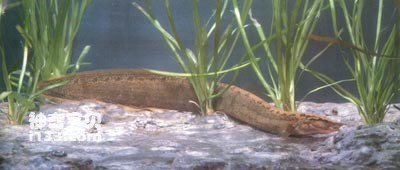The giant spiny loach (Mastacembelus armatus) belongs to the order Perciformes, the suborder Spiny Loach, the family Spiny Loach, and the genus Spiny Loach. Commonly known as: naconi, stone cone, burlap, pepper fish, saury fish. English name: Large spiny eel.
The body is slender, with the front part slightly flattened laterally and the tail flattened and thin. The head is long and pointed, with a long and pointed snout at the front end. The mouth is inferior, the cleft is shallow, almost triangular, and the corners of the mouth end below the choana. Both the upper and lower jaws have villous tooth belts; the eyes are located in the front of the head and are covered by a membrane. There is a small thorn with the tip pointing backward diagonally in front of the eye, buried in the skin. The posterior edge of the preopercular bone usually has 3 short spines. The body scales are very thin and the lateral lines are complete. The base of the dorsal fin is long, and the front part is composed of about 35 free short spines; the anal fin has 2 spines, and the third fin spine is often buried under the skin; the rays of the dorsal fin and anal fin are opposite, and the bases are extremely long and connected to the caudal fin. The pectoral fins are short and round, there is no pelvic fin, and the caudal fin is oblong. The dorsal side of the body is grey-brown or dark brown, and the abdomen is grey-yellow; there is often a black longitudinal band in the middle of the back of the head; there is also a black longitudinal band on the head side from the tip of the snout through the eyes to the top of the gill cover, which often breaks into one longitudinal line backward. Black spots extend along the base of the dorsal fin to the base of the caudal fin; there are light spots on the side of the body, showing black net patterns or wavy vertical stripes; the markings on large individuals are unclear. The pectoral fins are yellow-white, and the other fins are gray-black with light spots. There is a gray-white edge on the fin edge.
It inhabits rivers and streams with gravel bottoms, often hiding in rock crevices or caves, and feeds on small invertebrates and some plants.
Distributed in various water systems south of the Yangtze River. It is widely distributed in the south. The weight can reach 0.5 kg. The meat is tender and delicious, and is popular among the public.

animal tags:
We created this article in conjunction with AI technology, then made sure it was fact-checked and edited by a Animals Top editor.